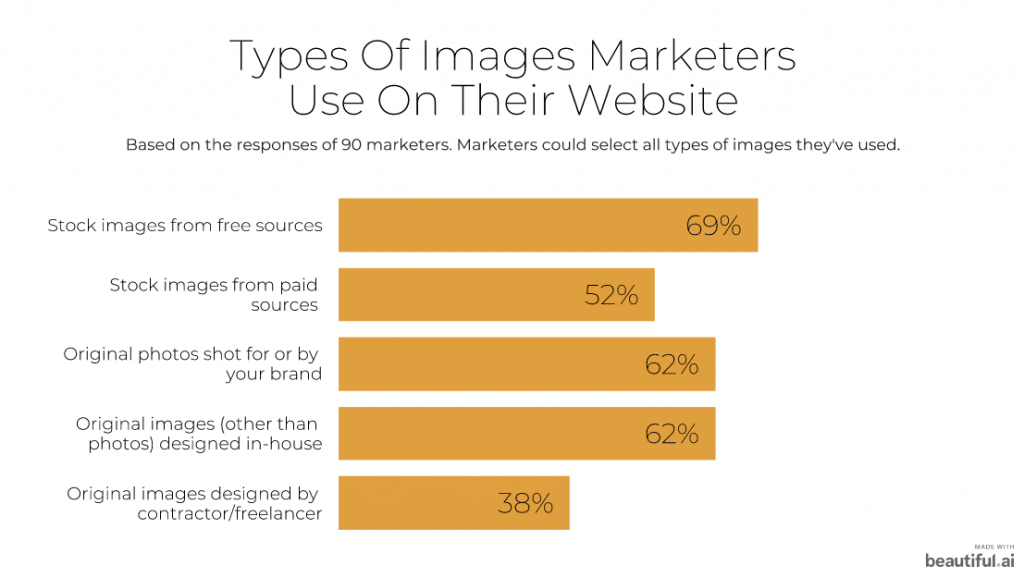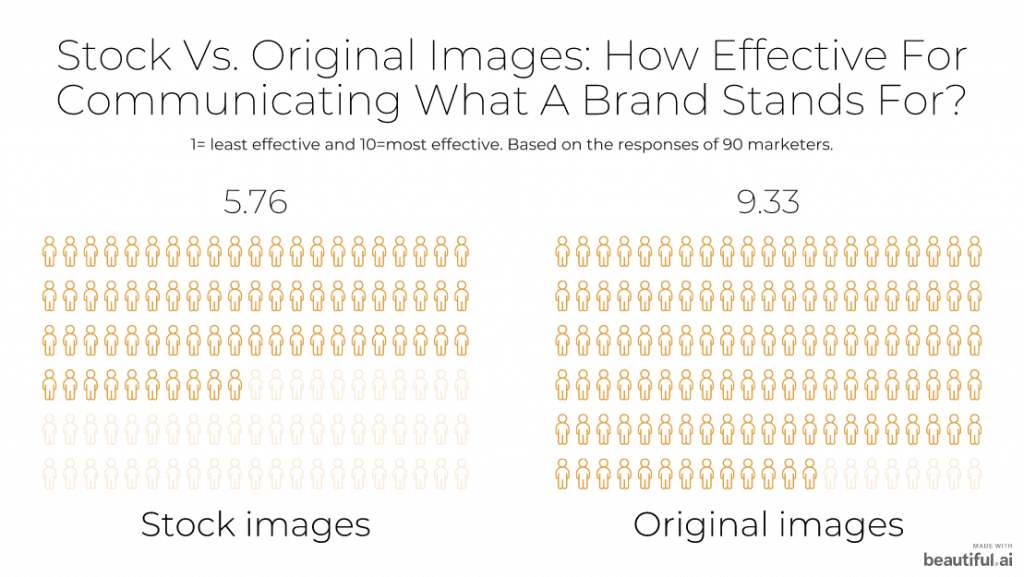Stock images vs. original images: What delivers better results?
You’ve spent hours writing the perfect copy for your page, and you’re almost done. Except, when it comes time to select visual elements, you get stuck over whether to use stock images.
Some of you might not give this much thought. Google a royalty image and consider the work done. Others among you might be hesitant.
The reality is that stock images aren’t always the best solution to your visual content problem. To better understand when it’s okay to use stock photography, we talked to 90 marketers.
We go over what we learned in this post. But first, let’s map out how many people source each type of image and how they rate the effectiveness of stock content vs. original images.
How many people use stock images?
A majority 69% of our respondents get stock images from free sources, such as Unsplash and Pexels. Closely following this, 62% take original photos. Another 62% use original images (other than photos) designed in-house.
Paid stock images are also a popular option, with 52% of marketers using them. Lastly, 39% outsource the job to freelancers/contractors who create original images for the brand.

We also asked how effective stock images are for brands, and got some interesting answers.
On a scale of 1 to 10 (1 meaning least effective and 10 meaning most effective), our respondents say stock images stand at 5.76 for communicating what a brand stands for. In contrast, original images got a whopping 9.33 out of 10 for effectively communicating what a brand stands for.

On the same scale, stock images get a score of only 5.47 when it comes to convincing someone to make a purchase. Original images, on the other hand, get an 8.98.

So are stock images worth the time it takes to find them? Our contributors give stock photos 7.33 on this.
Along the same line, are original photos worth the effort considering the time investment it takes to create them? Yes, as respondents give them a 8.38 out of 10.

Now, let’s talk about the cost. Contributors give stock images 7.28 out of 10 in terms of the monetary investment. Original images, on the flip side, get a 8.42 out of 10 for their monetary investment.

With that, let’s compare the two image types.
Should you use stock images? 17 marketers share their opinion
Most of the respondents we talked to say original images are better than stock images for several reasons.
Even so, stock images come with their benefits, however limited they may be. They’re a good alternative for times when you’re squeezed for time or don’t have the resources.
Let’s start by looking at the pros and cons of using stock images:
Advantages of stock images: Why you should be using them
In this section, let’s look at some perks of using stock images.
1. Stock images are budget-friendly
Often, you can get free stock images from sources like Pixabay, Unsplash, or DepositPhotos. Visuals from sources like these are royalty-free, so you won’t have to deal with copyright issues.
You can also access paid image sources. Although these come with a small cost, they’re less time-consuming (in terms of finding the right picture) as compared with free image sources, as Tihana Drumev from Best Response Media points out.
“Using paid stock images, from sources such as Shutterstock, is way quicker. The paid subscription cuts the time for the search, and you can stick to the same style of images,” Drumev explains.
Alex Williams of Turbo Gadget Reviews also thinks the biggest advantage of using stock images is their budget-friendliness. “When your website is relatively new, or when you’re not bringing in enough revenue to justify the cost of hiring someone to take original photos, stock photos are the most cost-effective option until you can scale up to affording original photos.”
2. Stock images are easily available
“The biggest advantage of stock photos is their easy availability,” notes Physicians Thrive’s Hamna Amjad.
“When you are short on time, you can simply download the relevant image from the stock photo repositories. All you have to do is search for the right image. The images come with both low- and high-resolution versions, so mostly you don’t even have to edit them.”
Put another way, when you’re pressed for time, a stock image can help since you don’t have to wait on the photographer, work out the ideal shot, and so on.
As Will Ward from TranslationEquipmentHQ puts it: “The biggest advantage of stock images is that they are easy to find and quick to use, as opposed to original images, which take a lot more thought and setup.”
3. Stock images are convenient to use
Stock images are a quick and easy source to elevate your brand. In contrast to having no images at all, these free image sources serve as hooks that attract and engage site visitors.
Bernice Quek from Progress ABMS talks about this perk of using stock images. “Stock images are ready-to-use images which you can easily incorporate into your website. They provide convenience and allow brands to elevate their website landing pages and articles. Images are crucial for conveying your intended messages while beautifying your pages to attract readers.”
4. Stock photos are good quality images
In addition to their pocket-friendly pricing, ease of use, and easy availability, stock content is also typically of a premium quality.
Fix The Photo’s Kate Gross observes, “Stock images are beautifully captured with optimized lights, resolution, and other editing effects.”
Again, this makes them a good option for your website’s visual content as compared with pictures taken by an inexperienced person.
5. They’re the best option for some industries
This one’s a point that Sarah Stromsdorfer from My OT Spot makes. “When running any healthcare blog, it is very challenging to find patients to take pictures of,” Stromsdorfer comments, “and due to HIPAA regulations, it is not legal for me to use pictures of any of my actual patients, or for any healthcare professional to do this unless the patient signs a waiver and the facility approves it.”
I find it to be much easier and safer to quickly find a stock image of an older adult or ‘patient’ in a hospital and just pay the $3, versus taking a tremendous amount of time hiring out people to act as patients.”
Stromsdorfer continues, “I think it’s much harder to take your own professional pictures of places, items, and situations, so I recommend stock images for most industries for ease.”
Additionally, “buying a stock photo is also a much safer bet than sourcing an image online and crediting it, because this can still come back and affect you legally if the original photographer wants to take legal action. I find the convenience and legal security totally worth the cost.”
The downsides of stock images: Why you should invest in original photography
Now, for why you shouldn’t be using stock images. Mark Armstrong from Mark Armstrong Illustration points out the demerits of stock images briefly: “The worst thing about stock images: They make you blend in. You become indistinguishable from competing brands because everyone’s using the same images. When you blend in, you become invisible. You have to make getting noticed your first priority.”
Other disadvantages Armstrong lists:
- “Eye-tracking studies show that people ignore purely decorative images. They pay attention to real people, but ignore generic stock people.
- “Odds are, you’ll settle for an image that only vaguely relates to your content, which tells readers you’re a brand that’s willing to take shortcuts.
- “Stock images are generic, so they arouse no curiosity. People are apt to keep scrolling.
- “Stock images diminish brand authenticity because they’re someone else’s vision of what you’re trying to convey.
- “We know they’re fake. We know that look. We see stock images over and over again because so many people use the same or similar photos.
- “Stock images send a silent message: ‘Just more of the same.’ Which makes people less inclined to read your content.
- “They’re not designed to fit your brand or your target audience.”
Let’s dive into the details of stock image disadvantages below:
1. Stock images are widely used
Since stock images are so easily available and often free or reasonably priced – which means almost everyone under the sun uses them. This indicates your ideal audience might have already seen the image that you use.
As Chad Sakonchick from BetterLegal notes, “there’s a chance the stock image of your choice is widely used among your competition, and that your target audience saw it several times already.” As a result, “using this type of image would give your page a disadvantage.”
It also creates what’s known as the “wallpaper effect, and waters down brand differentiation,” quips Scott Gardner from New Media Advisors. After all, “customers want real, meaningful interactions with your brand. Models smiling in picture-perfect settings is not the answer.”
Elite Content Marketer’s Chintan Zalani echoes the same. “The same set of stock images could be used by many other businesses, robbing your brand of being uniquely identifiable and memorable. Visuals also tend to have high retention.
So if a reader has a bad memory associated with a specific image you’re using (due to a bad experience with a certain brand that used the image in the past), it can trigger negative feelings for your brand as well.”
But how can you tell if a given image has been overused? Sakonchick has the answer for you. “To mitigate this threat, upload the image of your choice into Google Search and see how many times and where it was used previously. You’ll know for sure if you have a green light to include the picture in your content.”
2. Stock images don’t add to your brand personality
Stock images tend to be generic, widely used photos. So if you’re looking to stand out with a distinct brand personality, stock photos won’t help you.
On this note, Timmy Yanchun from LTHR Shaving shares, “Stock images just don’t have that unique touch brands need to be recognizable. They may be okay in a pinch, but it is always best to put in the effort for original images whenever possible.”
There’s also a lack of authenticity when it comes to stock photos, as Sharon Gourlay from Dive Into Tasmania observes. “In my industry [travel], the biggest disadvantage of using stock images and photos is the lack of authenticity for your brand. Most readers are smart enough to recognize stock photos, especially when they see the same photos on multiple sites.”
If you’re short on resources, consider adding a unique filter to a stock image to make it unique to your brand. Or, you can creatively edit a stock image by adding icons, shapes, or other design elements.
3. The stock image might not deliver your message
“The biggest disadvantage of using stock images and photos is it’s sometimes difficult to find an image that properly conveys what you’re trying to say,” Turbo Gadget Reviews’ Alex Williams highlights. “This is especially true in niche markets where there just aren’t many stock photo options out there.”
It’s also true for the healthcare industry as My OT Spot’s Sarah Stromsdorfer admits. “The biggest downside is finding the exact image or situation I need. If I need a picture of a patient doing a particular treatment, since my niche is fairly specific, it is rare to find exactly what I need when using stock photos. I have to compromise for a generic image of a ‘patient’ doing something similar to what I’m writing about, hoping my audience will realize it’s a broader image instead of an exact match.”
The takeaway? Stock images might work well for certain niche industries. For others such as ecommerce and the travel industry, you’ll be better off leveraging original photos for authenticity and delivering your message the way your want.
4. Audiences don’t respond well to stock photos
“I’ve noticed my readers don’t respond well when the images I use in my blog posts look like they’ve been taken from a stock image site,” shares Never Ending Footsteps’ Lauren Juliff. Consequently, Juliff takes good care to “select stock photos that don’t look like stock photos.”
The lack of trust surfaces from the fact that stock photos look staged. “I want my audience to be able to trust my opinion. And when I use photos I obviously haven’t taken, it diminishes that trust a little bit. If I give the impression I personally haven’t experienced the places I’m writing about, my readers aren’t going to take my recommendations as seriously, and I won’t make as much money through affiliate marketing.”
So how to get rid of this problem? Here’s what Juliff does: “I always try to use photos that don’t look posed or staged. I choose photos that look as though they could have been taken by an amateur photographer, rather than an expert, in order to form a stronger connection with my audience. It’s definitely tricky to find that balance, where the images you select make your posts look professional, but not too professional.”
5. Search engines don’t appreciate stock images as well
Timothy Woods from Carnivore Style makes this point. “Using original images has more SEO value than stock images. Original images have unique EXIF data that helps them show in search, which stock photos don’t have.”
On top of that, stock images aren’t typically UX friendly, Blake Bobit from Solution Scout observes. Bobit comments, “[the picture] doesn’t relate well with the content messaging [making it] a lot harder to convert your target reader.”
Poor user experience on your site due to such images might also result in reduced time on your site. This, in turn, impacts your ranking in the search engine. To add, original images help build links — something that stock photos can’t offer.
Wrapping up: When to use stock images and when not to
The correct answer of whether to use stock images depends on your industry and your objectives from your visual content.
In short, use stock images only when you are:
- Pressed for resources (time and budget) and you find it’s not sensible to invest at the moment.
On the other hand, consider original photography if you are:
- Looking to showcase your product. In that case, you need original photos to gain your audience’s trust by giving them a look at your product.
- Aiming for visual consistency, uniqueness, leaving a memorable impression or showcasing your brand personality with visuals on your website.
And, if you understand the drawbacks of stock images, but can’t afford to invest in original visuals, consider this alternative: Use a DIY design tool to create branded graphics. These are unique, authentic, and showcase your brand personality too. Here’s to creating visually engaging content.




